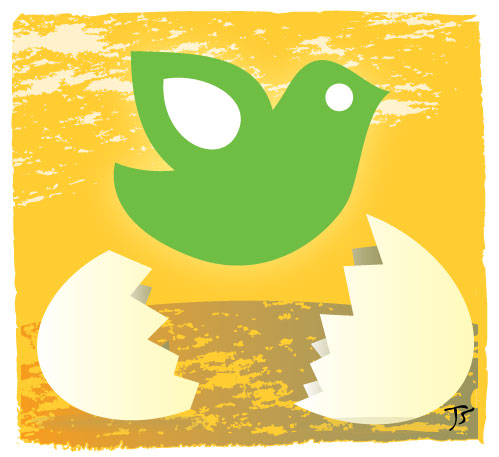
Sitting around the dinner table Christmas evening, the family conversation turned to smartphones. My parents were in the market for new phones. Their 2006 flip phones were sorely outdated, and were not displayed prominently on the table next to their dinner plates with the rest of the family’s devices. As everyone discussed their latest apps, my dad picked up my iPhone and started playing with it. After a few minutes, he became discouraged with the touch screen and declared that it was too frustrating to use.
I felt pretty “with it” and cool, until the conversation switched gears to Twitter and Quora. I didn’t get the point of “tweeting” and I had never even heard of Quora. As my younger cousins left me behind in the conversation, I realized I was quickly becoming out of touch with social media. I was on my way to becoming like my parents and their outdated phones!
It was then that I made my New Year’s resolution; to become more fluent with current and new social media platforms and to push myself to be an early adopter in the category.
I consider myself an average social media user. I joined Friendster and MySpace while in college, and now I visit my Facebook page at least once a day. But while I had a Twitter account, I never used it. Likewise, I started a blog but never promoted it. I had an interest, but I was too timid to jump in and commit.
Besides not wanting to fall behind the times, I was starting to notice how important social media was becoming at my job in higher education. Social media was brought up at nearly every meeting, with someone wanting to know how it could be leveraged to the school’s advantage. New social media platforms were constantly discussed; I got tired of being left out of the conversation. Schools and departments were looking to me for answers in this category, and I was unable to help them.
Working on my News Year’s resolution
After winter break, I decided to get going on my New Year’s resolution and start tackling Twitter. After requesting that the site email me my password (yes, it had been THAT long since I last logged on), I signed in. Then I stared at my empty friends list. Only one person followed me: my sister. I felt pretty lame.
After performing a few searches for people in higher ed, marketing and social media, I started to beef-up my “following” list. When I reached 30 people, I sat back and began to watch the tweets come through.
While some people tweeted fast and furiously (@markgr and @mashable), others barely tweeted at all. After a week of following the same people I soon became discouraged: this was uninteresting and seemed pointless. I obviously wasn’t getting something.
Determined not to give up on Twitter just yet, I did some research and discovered that downloading a tool to help organize tweets might help me follow more people with similar interests. TweetDeck fit the bill, and it was up and running on my computer within five minutes.
The next step was to add columns on TweetDeck using hashtags (the # symbol, for those unfamiliar). I then started following a stream of keywords including #highered and #socialmedia.
As these columns whirred with activity, I started to realize what I was missing. When a Twitter user had something to say to a specific group, he or she would add a hashtag to the post. For example, if a higher ed professional wanted to share an article recently posted on a blog, the user could share the URL by tweeting with #highered. The tweet would then become visible to everyone following that hashtag.
By following #highered and #socialmedia for only a few days, I noticed that news was coming to me. I no longer had to seek out new information. News articles, blog entries and discussion groups were constantly shared, and I even found it hard to keep up with all the industry’s current events.
After a few weeks of following groups through TweetDeck, I started to feel like I was finally getting the hang of Twitter. It was no longer a pointless site used to share what someone had for lunch; it became a valuable tool to help share higher ed news, as well as trends in technology and social media.
For those interested in Twitter, here are some simple steps to get you going
- Open a Twitter account. It’s easy; just visit twitter.com and follow the instructions. Make sure to fill out your bio; others will be interested in what you’re all about.
- Download a tool to help organize your tweets. Some tools available include TweetDeck, Destroy Twitter and Seesmic Desktop.
- Start following people in higher ed and other topics of interest to you. Keep in mind that user handles will have the @ symbol in front of them.
- Add hashtag columns to start following areas of interest. Hashtags to consider are #highered, #socialmedia, #marketing, and #edunews.
- Start tweeting. You have to become part of the conversation in order to fully understand the value of this medium.>
Similar to those resolving to lose weight or get in better physical shape, I’m determined not to let my social media chops go flabby in 2011. This year I’ll whip myself into tip-top social media shape. I’m resolving to get at least 500 followers on Twitter (I only have 23 right now), become fluent with Quora, follow new sites like CollegeOnly.com, and record my progress for others to follow and comment on. At next year’s Christmas dinner I’m going to be the one leading the conversation on social media, not left behind.


One reply on “Social Media Novice”
[…] Social Media Novice […]